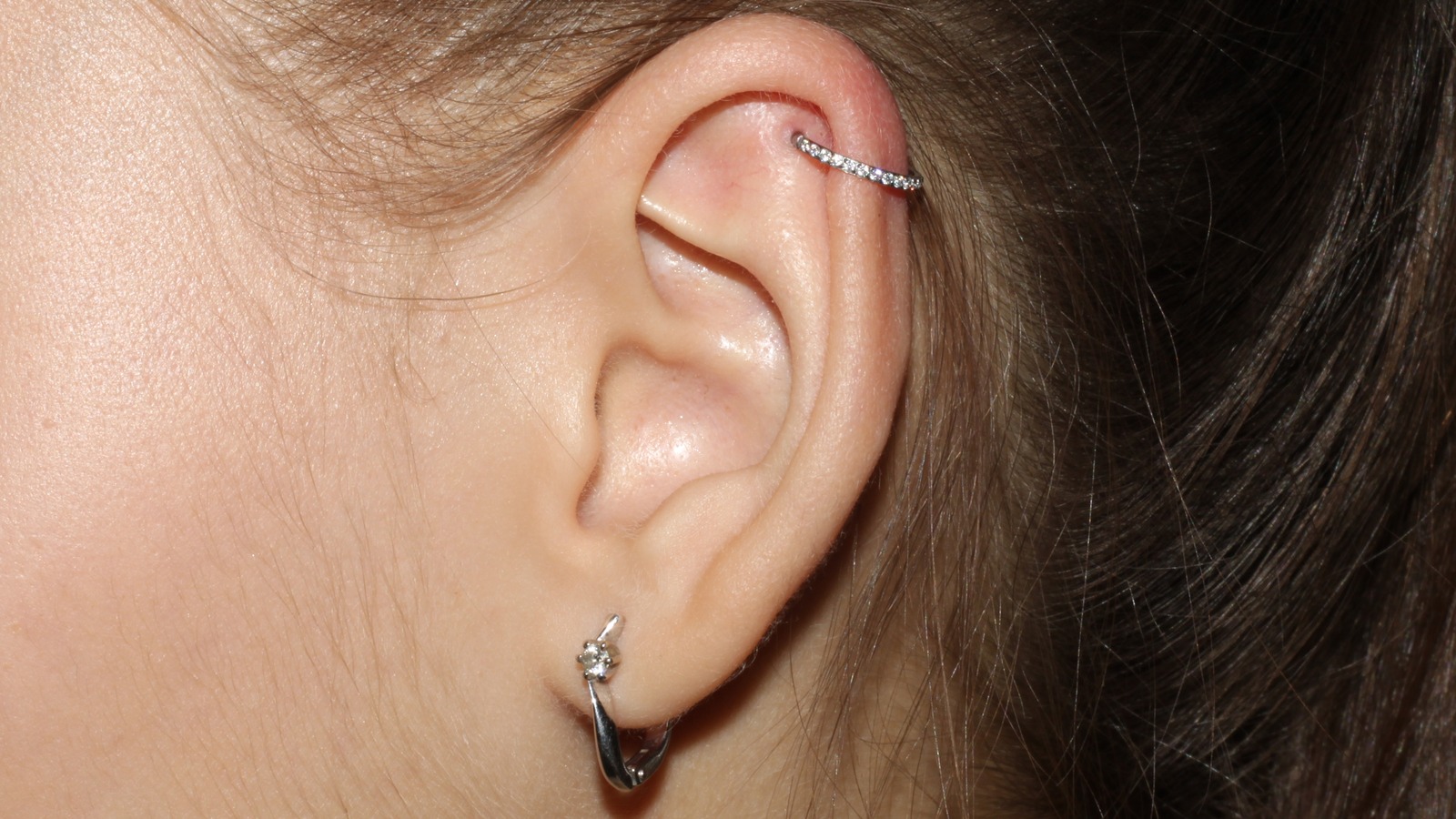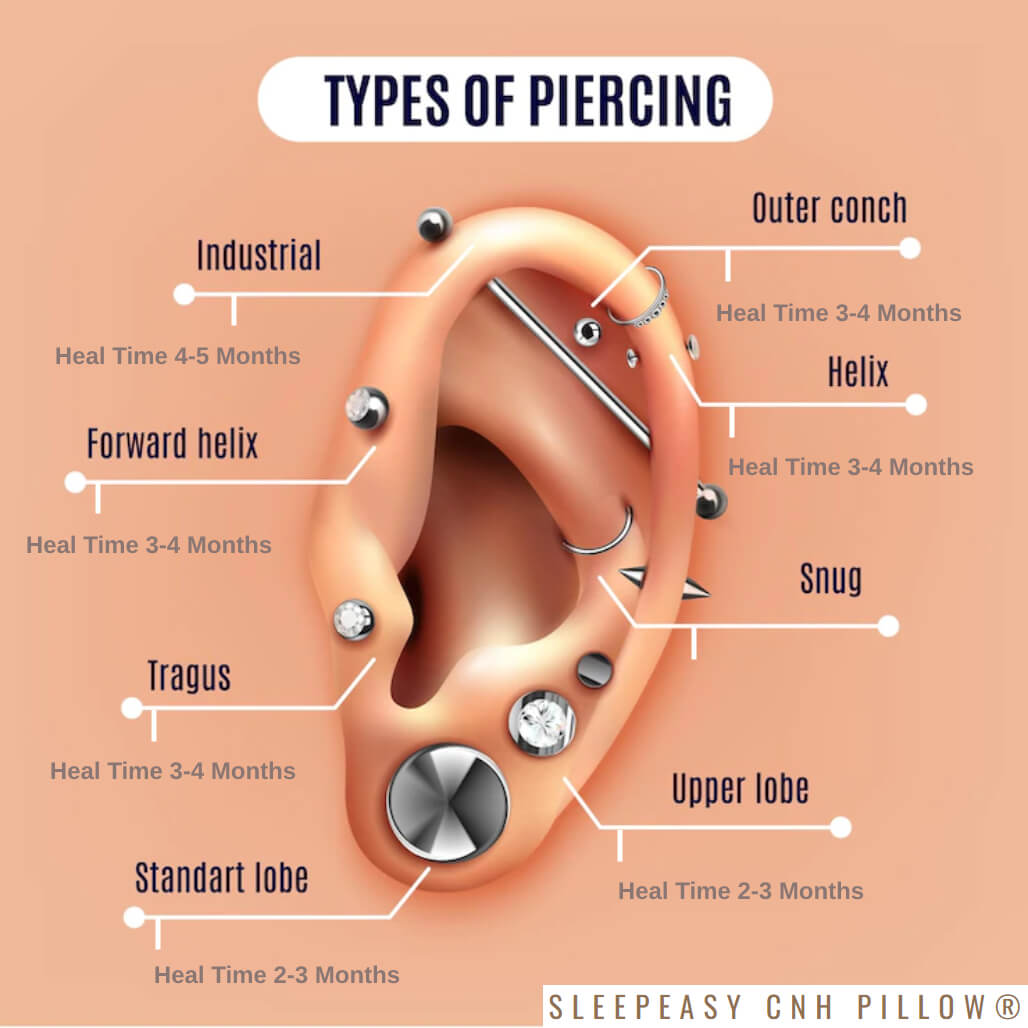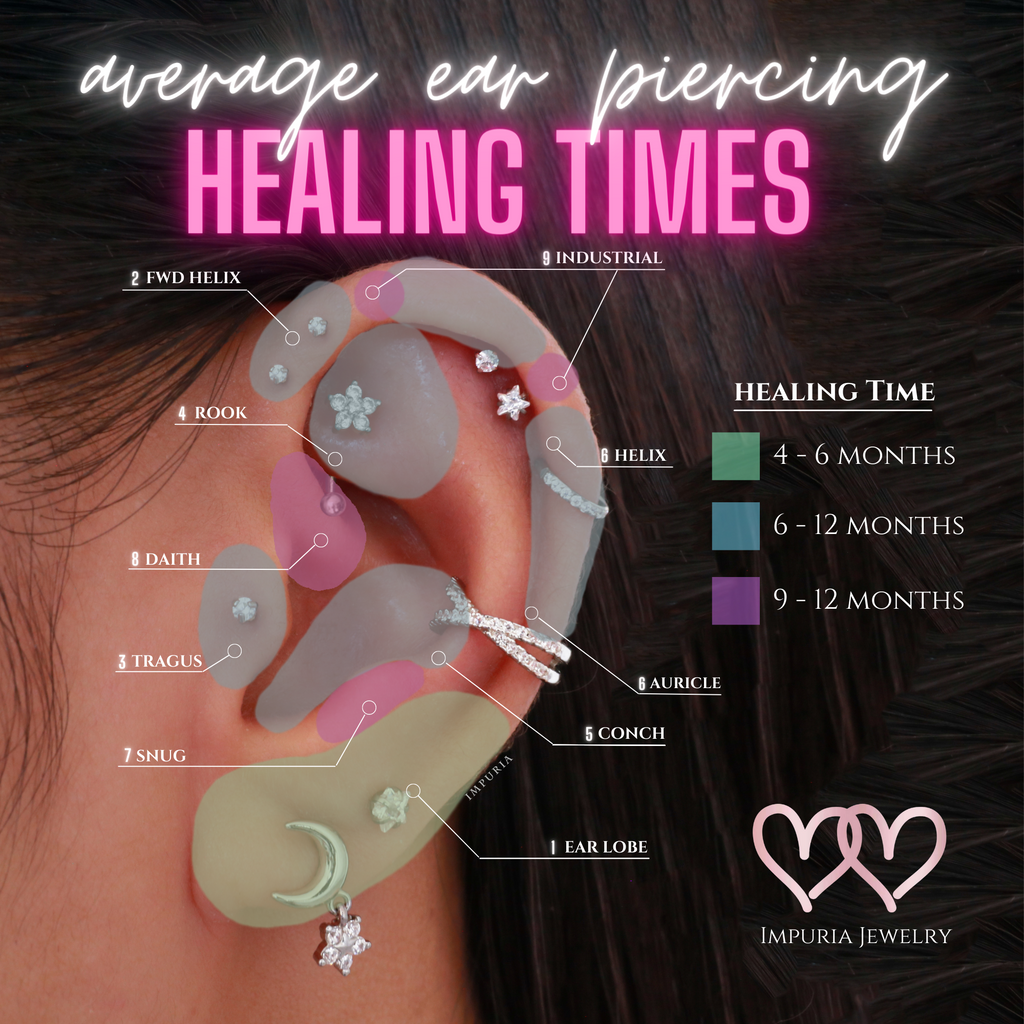Navigating Cartilage Piercing Healing: What To Expect & How Long?
Getting a new cartilage piercing is an exciting step, adding a unique touch to your personal style. However, one of the most common questions that arises, and often causes a bit of anxiety, is: how long do cartilage piercings take to heal? Unlike earlobe piercings, which often heal relatively quickly, cartilage piercings require a significant commitment to aftercare and patience due to their unique physiological characteristics. Understanding the healing process is crucial for a successful outcome and to prevent complications.
The journey to a fully healed cartilage piercing isn't a race; it's a marathon. There's no one-size-fits-all answer to the healing timeline, as it's influenced by a myriad of factors, including your individual body's healing capabilities, the specific location of the piercing, and most importantly, your diligent adherence to aftercare routines. This comprehensive guide will delve into everything you need to know about the cartilage piercing healing process, setting realistic expectations and providing actionable advice to ensure your new adornment heals beautifully.
Table of Contents
- Understanding Cartilage Piercings: More Than Just a Hole
- The Core Question: How Long Do Cartilage Piercings Take to Heal?
- Factors Influencing Your Cartilage Piercing Healing Journey
- Stages of Cartilage Piercing Healing: What to Look For
- Essential Aftercare Tips for Optimal Healing
- Recognizing a Fully Healed Cartilage Piercing
- Common Pitfalls and How to Avoid Them
- When to Seek Professional Advice
Understanding Cartilage Piercings: More Than Just a Hole
Before diving into healing times, it's essential to understand what a cartilage piercing actually is. Cartilage piercing involves puncturing the flexible tissue that covers the ear, a distinct difference from the fleshy lobe. This tissue is firmer and less vascular than the earlobe, which plays a significant role in its healing duration. The key difference lies in blood supply. Cartilage has a limited blood supply compared to the highly vascularized earlobe. This limited blood flow means that nutrients and oxygen, vital for tissue repair and regeneration, are delivered at a slower rate. Consequently, they may take longer to heal as compared to lobe piercing due to the limited blood supply in the cartilage, which may take anywhere between 6 to 12 months. This physiological reality is the primary reason why patience is paramount when it comes to how long do cartilage piercings take to heal.The Core Question: How Long Do Cartilage Piercings Take to Heal?
So, let's address the central question: how long do cartilage piercings take to heal? The straightforward answer is that there's no definitive timeline. While many sources provide an average, individual experiences can vary wildly. According to professional piercers, the average healing time for a cartilage piercing is around 6 to 12 months. However, this timeline can vary from person to person. Some individuals might experience significant healing in a few months, while for others, complete cartilage piercing healing may take up to 12 months, or even longer. A good estimate is that it will take somewhere between six and nine months to heal fully. Generally, you can expect your piercing to heal anywhere between 3 months to a whole year, depending on the piercing and the aftercare process. The typical healing duration for cartilage piercings ranges between 4 and 12 months, varying with the person and their aftercare. This longer healing time is due to the thicker and less vascular nature of cartilage compared to the earlobe.Factors Influencing Your Cartilage Piercing Healing Journey
Understanding that the healing timeline is highly individual is the first step. Now, let's explore the specific factors that contribute to this variability. Your healing times will depend upon your adherence to aftercare, your body’s ability to heal itself, and whether your piercing encounters any complications.Individual Body Chemistry & Overall Health
Your body's inherent ability to heal itself plays a massive role. Factors such as your immune system strength, nutrition, hydration, and even stress levels can significantly impact how quickly your cartilage piercing heals. Someone with a robust immune system and a healthy lifestyle might find their piercing healing faster than someone who is run down or has underlying health conditions. Overall health, as well as aftercare, are part of the healing process. Chronic illnesses, certain medications, and even habits like smoking can impede the healing process by affecting blood circulation and immune response. A well-nourished body is better equipped to repair tissue and fight off potential infections.Piercing Location Matters
Not all cartilage is created equal when it comes to healing. The specific location of your cartilage piercing on the ear can influence its healing time. Some cartilage piercings like the tragus and the helix will likely heal faster than ones like the rook or snug. This is often due to the amount of movement the area experiences, its exposure to external elements, and subtle differences in cartilage thickness and blood supply in various parts of the ear. For instance, a helix piercing on the outer rim of the ear might be less prone to irritation from hair or sleeping positions than a snug or rook piercing, which are tucked deeper within the ear's folds. The exact duration varies based on the specific area pierced and the individual’s healing.The Critical Role of Aftercare
This cannot be stressed enough: aftercare is paramount. Your healing times will depend upon your adherence to aftercare. Proper and consistent aftercare can significantly shorten your healing time and prevent complications. Conversely, neglecting aftercare can prolong the healing process indefinitely or lead to serious issues. Complete cartilage piercing healing may take up to 12 months, so it is important to take proper care of the pierced area. This involves regular cleaning, avoiding unnecessary touching, and protecting the piercing from trauma. How well the piercing is cared for is a primary determinant of its healing success.Complications and Their Impact
Even with the best intentions, complications can arise. Infections, irritation bumps (like hypertrophic scarring or keloids), or excessive trauma to the piercing can set back the healing process considerably. If your piercing becomes infected, inflamed, or develops a bump, it will naturally take much longer to heal. These issues often require professional intervention and can add months to your healing journey. Avoiding pressure or irritation, such as from headphones, hats, or sleeping on the piercing, is crucial. Whether your piercing encounters such issues directly impacts how long do cartilage piercings take to heal.Stages of Cartilage Piercing Healing: What to Look For
The healing of any piercing, including cartilage, is a process that occurs in distinct stages, healing from the inside out. Understanding these stages can help you gauge your progress and identify any potential issues early on. 1. **Inflammatory Phase (Days 1-7):** Immediately after the piercing, you'll experience redness, swelling, tenderness, and possibly some clear or yellowish discharge. This is your body's natural response to trauma, initiating the healing process. It's crucial not to mistake this normal inflammation for infection. 2. **Proliferative/Granulation Phase (Weeks 2-12):** During this stage, your body starts to form new tissue. You might notice some crusting around the piercing site as lymph fluid dries. Inside the piercing channel, collagen fibers are being laid down to create a new skin tunnel. The initial tenderness should subside, though the area may still be sensitive. 3. **Remodeling/Maturation Phase (Months 3-12+):** This is the longest phase, where the newly formed tissue strengthens and matures. The piercing channel becomes fully formed and smooth. The redness and swelling should be completely gone, and the piercing should feel solid and comfortable. A fully "seasoned" piercing means the tissue is strong and stable, often taking up to one year to heal completely and become “seasoned.” This is when you can consider changing jewelry more freely.Essential Aftercare Tips for Optimal Healing
Diligent aftercare is the cornerstone of a successful cartilage piercing healing journey. The good news is that it’s not hard. Here are the key practices: * **Clean Regularly:** Make sure to keep the area clean. Clean it regularly, typically twice a day, using a sterile saline solution (0.9% sodium chloride) or a piercing-specific aftercare spray. Avoid harsh chemicals like alcohol, hydrogen peroxide, or antibacterial soaps, as these can irritate the delicate healing tissue and prolong the healing time. * **Avoid Touching:** Resist the urge to touch your piercing unnecessarily. Your hands carry bacteria, and touching can introduce germs, leading to infection. Avoid touching it frequently. * **Do Not Rotate/Spin Jewelry:** Contrary to old advice, spinning or rotating a new cartilage piercing can actually disrupt the delicate healing tissue inside the channel, causing irritation and prolonging healing. Leave the jewelry alone. * **Protect from Trauma:** Be patient and avoid pressure or irritation. This means being mindful of how you sleep (consider a donut pillow or travel pillow), avoiding tight hats, headphones that press on the piercing, and rough handling of your hair. Any trauma can cause irritation bumps or delay healing. * **Maintain Overall Health:** A healthy body heals better. Ensure you're getting adequate sleep, eating a nutritious diet, staying hydrated, and managing stress. * **Shower Carefully:** Allow water to rinse over the piercing in the shower, but avoid direct, strong streams. Clean it after shampooing or conditioning to remove any product residue.Recognizing a Fully Healed Cartilage Piercing
Knowing when your cartilage piercing is truly healed is crucial before considering a jewelry change or assuming it's problem-free. A fully healed piercing will exhibit the following signs: * **No Redness or Swelling:** The area around the piercing should match your natural skin tone, with no signs of inflammation. * **No Pain or Tenderness:** You should be able to touch the area without any discomfort or sensitivity. * **No Discharge:** There should be no crusting, pus, or any kind of discharge. * **No Itching or Irritation:** The piercing site should feel completely normal. * **Jewelry Moves Freely (But Don't Force It):** The jewelry should move smoothly within the channel, indicating a fully formed skin tunnel. However, this doesn't mean you should force it to move; just observe its natural state. Even when it appears healed on the outside, remember that cartilage piercings heal from the inside out. It's always best to consult with your professional piercer before changing jewelry, especially for the first time, to ensure the channel is fully mature.Common Pitfalls and How to Avoid Them
Despite careful aftercare, some common issues can arise during the healing of a cartilage piercing. Being aware of these can help you avoid them or address them promptly. * **Infection:** Characterized by excessive redness, swelling, throbbing pain, warmth, and thick, discolored discharge (yellow, green, or grey) often accompanied by a foul odor. If you suspect an infection, do not remove the jewelry. Seek professional medical advice immediately. * **Irritation Bumps:** These are often mistaken for keloids but are usually hypertrophic scars or pustules caused by trauma, pressure, or improper aftercare. They are typically flesh-colored or reddish bumps right next to the piercing. They can be resolved with proper care and eliminating the source of irritation. * **Premature Jewelry Changes:** Changing your jewelry too soon can damage the fragile, still-healing tissue inside the piercing channel, leading to irritation, infection, or prolonged healing. Always wait until your piercer gives you the go-ahead. * **Sleeping on the Piercing:** Constant pressure from sleeping on your new piercing is one of the most common causes of irritation bumps and delayed healing. Invest in a donut-shaped pillow or a travel pillow to keep pressure off your ear. * **Using Incorrect Jewelry:** The initial jewelry should be made of implant-grade material (like titanium or surgical stainless steel) and be appropriately sized to allow for initial swelling. Using low-quality materials or jewelry that is too tight can cause significant problems.When to Seek Professional Advice
While this article provides comprehensive guidance, remember that professional piercers are your best resource. If you experience any of the following, don't hesitate to contact your piercer or a medical professional: * **Signs of Infection:** As described above, severe pain, swelling, heat, and discolored discharge. * **Persistent Irritation:** If irritation bumps don't improve with diligent aftercare or worsen. * **Jewelry Issues:** If your jewelry feels too tight, is embedding in your skin, or you're having trouble with it. * **Unusual Symptoms:** Any concern that deviates from normal healing. They can assess the situation, offer tailored advice, or recommend medical attention if necessary.So, if you’re nervous about the long healing time, remember that patience and proper care are your best allies. Cartilage is much harder to pierce than the skin, so it naturally requires more time and attention to heal properly.
- Amber Ajami Leaked
- Is Yasmeen Ghauris Daughter A Model
- Alyxstar
- Vegamovies Nl 300mb 480p 720p And 1080p Movies
- Danny Zugelder
Ultimately, your healing times will depend upon your adherence to aftercare, your body’s ability to heal itself, and whether your piercing encounters any issues. The average healing time is 8 months, but it can take up to 12 months. Be patient and avoid pressure or irritation. Avoid touching it frequently and clean it regularly. The good news is that it’s not hard. Make sure to keep the area clean and avoid unnecessarily irritating it.
As mentioned, the healing time for cartilage piercings can range from 4 months to a year. Cartilage piercings normally take anywhere from 4 to 12 months to completely heal. This longer healing time is due to the thicker and less vascular tissue. Though it will vary from person to person, you can expect your piercing to heal anywhere between 3 months to a whole year, depending on the piercing and the aftercare process.
First of all, there's no definitive timeline as to exactly how long it will take for a cartilage piercing to heal because overall health, as well as aftercare, are part of the healing process. Someone can heal in a few months, while others can take longer. Due to lower blood flow, cartilage takes longer to heal. Cartilage piercing can take between 3 and 6 months to heal, with some piercings even taking up to one year to heal completely and become “seasoned”.
- Vegamovies Manamey
- Okkhatrimazacom 2024
- Is Richard Hy Married
- Mp4moviez Nl
- Skymovies Bengali Movies Download
As with all piercings, they heal from the inside out. Your healing times will depend upon your adherence to aftercare, your body’s ability to heal itself, and whether your piercing encounters any complications.
Conclusion
Understanding how long do cartilage piercings take to heal is key to a successful piercing experience. While the average healing time for a cartilage piercing ranges from 6 to 12 months, remember that this is a highly individual journey influenced by your body, the piercing's location, and most critically, your commitment to diligent aftercare. Patience, consistency, and a proactive approach to potential issues are your best tools. By following the aftercare guidelines, being mindful of potential irritants, and seeking professional advice when needed, you can ensure your cartilage piercing heals beautifully and becomes a cherished part of your personal expression. Don't rush the process; a fully healed piercing is worth the wait. Have you recently gotten a cartilage piercing? Share your healing journey and tips in the comments below! If you found this article helpful, consider sharing it with friends who are also embarking on their piercing adventure.


Detail Author:
- Name : Celia Reichert
- Username : cbayer
- Email : emmerich.aryanna@fay.com
- Birthdate : 1983-11-29
- Address : 52110 Upton Alley Suite 427 Lake Kamilleville, IL 91390
- Phone : 321.376.0878
- Company : Wehner-Pagac
- Job : Terrazzo Workes and Finisher
- Bio : Laborum et harum officia ut necessitatibus a dolores. In libero laudantium ipsa aliquid iusto nostrum. Ut blanditiis vel quo atque omnis atque. Sint fugiat earum laudantium ipsa labore ut et qui.
Socials
instagram:
- url : https://instagram.com/francisco_dev
- username : francisco_dev
- bio : Rerum consequatur animi enim ad. Atque ut itaque blanditiis illum quod. Laudantium sequi aut quia.
- followers : 939
- following : 2035
facebook:
- url : https://facebook.com/franciscowindler
- username : franciscowindler
- bio : Ipsam nobis sit ipsum reiciendis omnis.
- followers : 5295
- following : 303
twitter:
- url : https://twitter.com/francisco2315
- username : francisco2315
- bio : Velit consequuntur unde enim omnis laborum. Quidem ipsam non rerum in hic nisi sit dolores. Earum soluta officia totam excepturi omnis asperiores officiis.
- followers : 1188
- following : 2257
linkedin:
- url : https://linkedin.com/in/fwindler
- username : fwindler
- bio : Earum quos odit aut aut ut nemo.
- followers : 2685
- following : 747
tiktok:
- url : https://tiktok.com/@franciscowindler
- username : franciscowindler
- bio : Voluptates adipisci enim impedit nobis esse est sed aliquid.
- followers : 1089
- following : 1796
